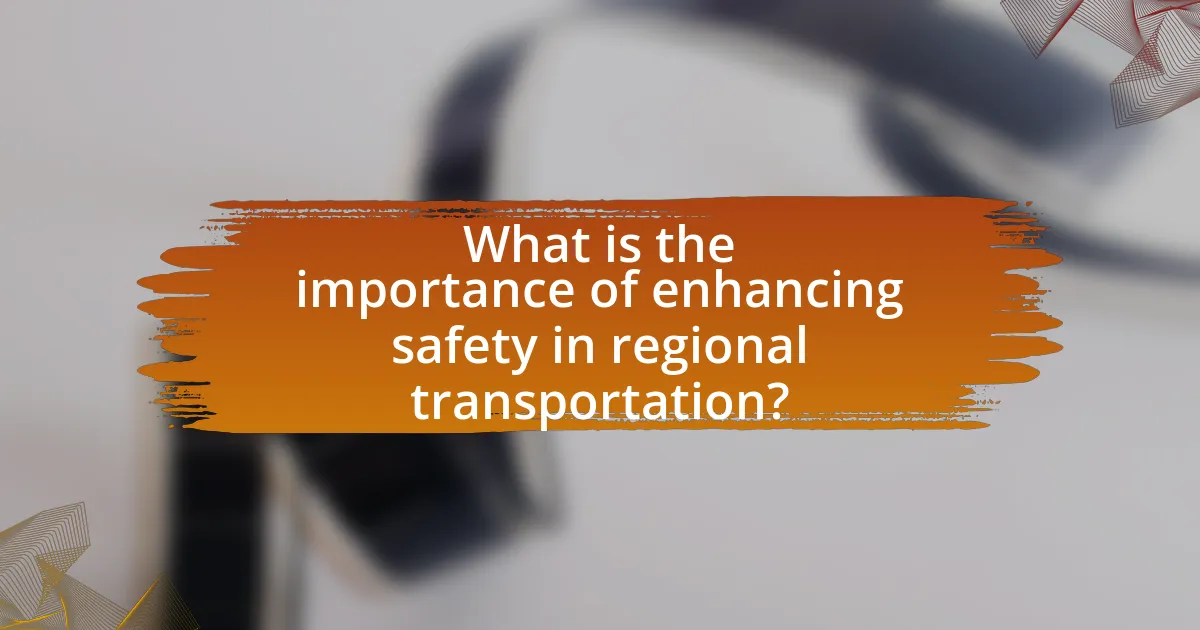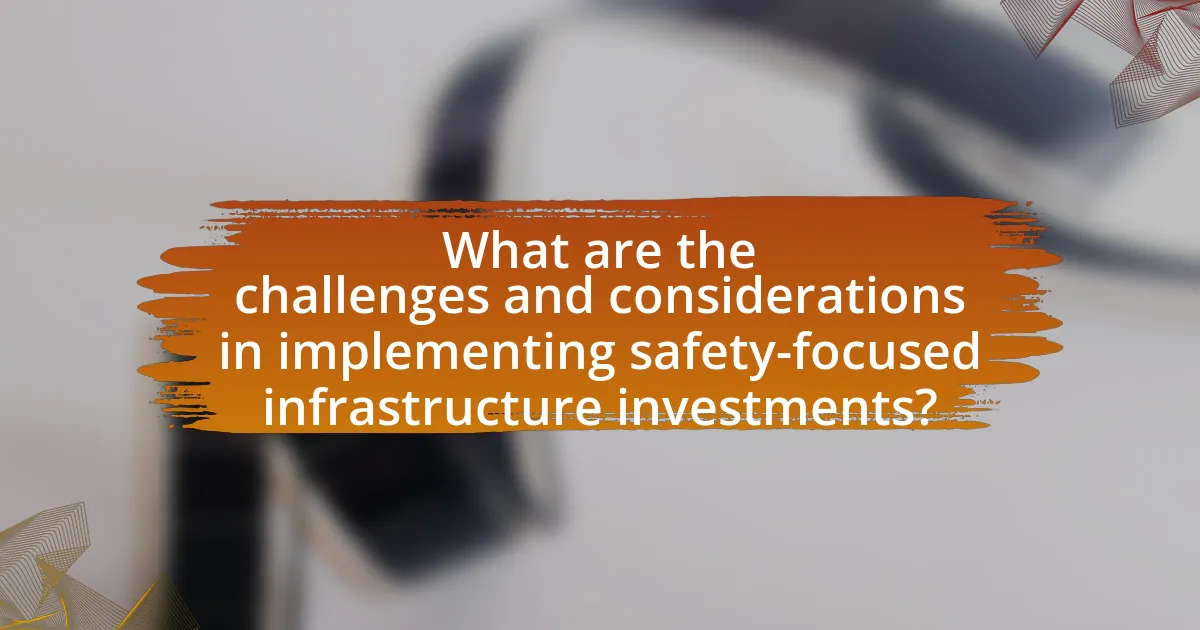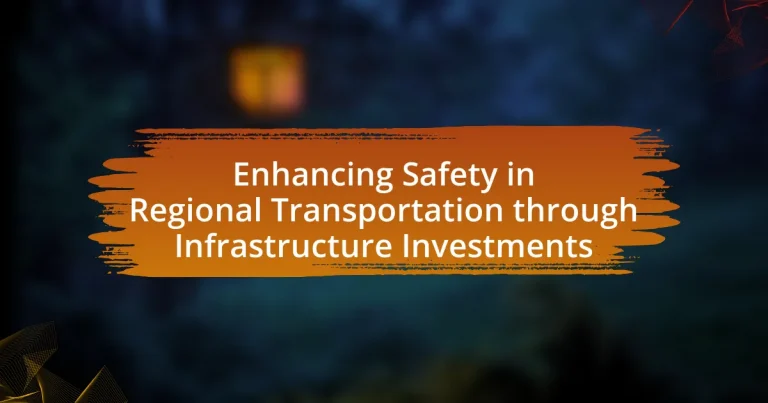Enhancing safety in regional transportation through infrastructure investments is essential for reducing accidents and fatalities, ultimately benefiting public health and economic stability. The article outlines the significance of improved road design, signage, and traffic management systems, which can lead to substantial decreases in crash rates. It discusses effective infrastructure improvements, such as roundabouts and dedicated bike lanes, and highlights the role of technology and data analytics in optimizing safety measures. Additionally, it addresses common challenges in implementing safety-focused investments and emphasizes the importance of community engagement in the planning process to ensure relevant and effective safety solutions.

What is the importance of enhancing safety in regional transportation?
Enhancing safety in regional transportation is crucial for reducing accidents and fatalities. Improved safety measures lead to a decrease in traffic-related injuries and deaths, which statistics show can significantly lower the economic burden on healthcare systems and society. For instance, the National Highway Traffic Safety Administration reported that in 2020, there were over 38,000 fatalities in motor vehicle crashes in the United States, highlighting the urgent need for safety enhancements. By investing in infrastructure improvements, such as better road design, signage, and traffic management systems, regions can create safer travel environments, ultimately fostering public confidence in transportation systems and promoting economic growth.
How do infrastructure investments contribute to transportation safety?
Infrastructure investments significantly enhance transportation safety by improving road conditions, increasing visibility, and implementing advanced traffic management systems. Well-maintained roads reduce the likelihood of accidents caused by potholes or poor surfaces, while better lighting and signage help drivers navigate safely, especially at night or in adverse weather conditions. For instance, the Federal Highway Administration reports that road improvements can lead to a 30% reduction in crash rates. Additionally, investments in technology, such as smart traffic signals and real-time monitoring systems, facilitate smoother traffic flow and reduce congestion, further minimizing the risk of collisions.
What types of infrastructure improvements are most effective for safety?
Infrastructure improvements that are most effective for safety include the installation of roundabouts, enhanced lighting, and the implementation of dedicated bike lanes. Roundabouts reduce the likelihood of severe collisions by minimizing conflict points and lowering vehicle speeds, as evidenced by a study from the Insurance Institute for Highway Safety, which found that roundabouts can reduce injury crashes by up to 75%. Enhanced lighting in high-traffic areas improves visibility and decreases accident rates, supported by research from the Federal Highway Administration indicating that well-lit intersections can reduce nighttime crashes by 30%. Dedicated bike lanes separate cyclists from motor vehicle traffic, significantly lowering the risk of accidents, with a report from the National Association of City Transportation Officials showing that cities with protected bike lanes experience a 40% reduction in cyclist injuries.
How do these improvements impact accident rates?
Improvements in infrastructure significantly reduce accident rates. Enhanced road conditions, better signage, and upgraded traffic signals contribute to safer driving environments, leading to fewer collisions. For instance, a study by the Insurance Institute for Highway Safety found that modern roundabouts can reduce injury crashes by up to 75% compared to traditional intersections. Additionally, the Federal Highway Administration reported that road improvements, such as adding bike lanes and pedestrian crossings, have led to a 20% decrease in accidents in urban areas. These statistics demonstrate that targeted infrastructure investments directly correlate with lower accident rates.
Why is regional transportation safety a critical issue?
Regional transportation safety is a critical issue because it directly impacts public health, economic stability, and community well-being. Unsafe transportation systems lead to higher rates of accidents, injuries, and fatalities; for instance, the National Highway Traffic Safety Administration reported over 38,000 fatalities in the U.S. in 2020 alone. Furthermore, inadequate safety measures can hinder economic growth by increasing costs related to healthcare, insurance, and lost productivity. Investing in infrastructure improvements, such as better road design and maintenance, can significantly enhance safety outcomes, as evidenced by studies showing that well-maintained roads reduce crash rates by up to 30%.
What are the common safety challenges faced in regional transportation?
Common safety challenges faced in regional transportation include inadequate infrastructure, driver behavior, and weather conditions. Inadequate infrastructure often leads to poorly maintained roads and insufficient signage, which can increase the likelihood of accidents. Driver behavior, such as speeding, distracted driving, and driving under the influence, significantly contributes to road safety issues. Additionally, adverse weather conditions, including rain, snow, and fog, can impair visibility and road traction, further complicating safe travel. According to the National Highway Traffic Safety Administration, approximately 94% of serious crashes are attributed to human error, highlighting the critical role of driver behavior in regional transportation safety.
How does regional transportation safety affect community well-being?
Regional transportation safety significantly enhances community well-being by reducing accidents and fatalities, which fosters a sense of security among residents. Improved safety measures, such as better road infrastructure and traffic management systems, lead to fewer injuries and deaths, thereby promoting public health. For instance, the National Highway Traffic Safety Administration reported that effective safety interventions can reduce crash rates by up to 30%. Additionally, safer transportation systems encourage community engagement and economic activity, as residents feel more comfortable traveling for work, education, and leisure. This interconnectedness contributes to a stronger community fabric and overall quality of life.

What are the key infrastructure investments that enhance safety?
Key infrastructure investments that enhance safety include the construction of modern roadways, installation of advanced traffic management systems, and the development of pedestrian and cyclist infrastructure. Modern roadways, designed with safety features such as better signage, lighting, and lane markings, significantly reduce accident rates. Advanced traffic management systems, which utilize real-time data to optimize traffic flow and reduce congestion, have been shown to decrease the likelihood of collisions. Additionally, dedicated pedestrian and cyclist infrastructure, such as bike lanes and crosswalks, promotes safe travel for non-motorized users, leading to lower injury rates. According to the National Highway Traffic Safety Administration, implementing these safety-focused infrastructure improvements can lead to a reduction in traffic fatalities by up to 30%.
How do road design and maintenance influence safety outcomes?
Road design and maintenance significantly influence safety outcomes by directly affecting vehicle control, visibility, and the likelihood of accidents. Well-designed roads incorporate features such as proper signage, adequate lighting, and appropriate lane widths, which enhance driver awareness and reduce the risk of collisions. For instance, a study by the Federal Highway Administration found that roads with clear markings and signage can reduce crash rates by up to 30%. Additionally, regular maintenance, including pothole repairs and surface treatments, ensures that road conditions remain safe for all users, further decreasing the potential for accidents.
What specific design features improve road safety?
Specific design features that improve road safety include roundabouts, dedicated bike lanes, pedestrian crossings, and improved signage. Roundabouts reduce the likelihood of high-speed collisions by promoting slower vehicle speeds and minimizing conflict points. Dedicated bike lanes separate cyclists from motor vehicle traffic, decreasing the risk of accidents. Well-marked pedestrian crossings enhance visibility and safety for pedestrians, while improved signage provides clear information to drivers, reducing confusion and potential hazards. According to the Federal Highway Administration, roundabouts can reduce fatal crashes by up to 90%, demonstrating the effectiveness of these design features in enhancing road safety.
How does regular maintenance contribute to safer transportation networks?
Regular maintenance significantly contributes to safer transportation networks by ensuring that infrastructure remains in optimal condition, thereby reducing the likelihood of accidents. Well-maintained roads, bridges, and transit systems minimize hazards such as potholes, structural failures, and malfunctioning signals, which are common causes of transportation-related incidents. For instance, the Federal Highway Administration reports that proper maintenance can reduce crash rates by up to 30% in areas where road conditions are improved. This correlation highlights the critical role of regular inspections and timely repairs in enhancing overall safety for all users of the transportation network.
What role does technology play in enhancing transportation safety?
Technology plays a crucial role in enhancing transportation safety by integrating advanced systems that monitor, analyze, and improve traffic conditions. For instance, the implementation of intelligent transportation systems (ITS) utilizes real-time data to manage traffic flow, reduce congestion, and minimize accidents. According to the U.S. Department of Transportation, ITS can decrease crash rates by up to 30% through features like adaptive traffic signals and vehicle-to-infrastructure communication. Additionally, technologies such as automated braking systems and collision avoidance systems in vehicles significantly reduce the likelihood of accidents, with studies showing that these systems can prevent up to 40% of crashes. Thus, technology not only improves safety measures but also actively contributes to reducing the frequency and severity of transportation incidents.
How can smart traffic management systems improve safety?
Smart traffic management systems improve safety by utilizing real-time data to optimize traffic flow and reduce congestion. These systems employ technologies such as sensors, cameras, and artificial intelligence to monitor traffic conditions, enabling timely responses to incidents and hazards. For instance, studies have shown that cities implementing smart traffic systems experience a reduction in traffic accidents by up to 30%, as they can dynamically adjust signal timings and provide drivers with real-time information about road conditions. This proactive approach not only enhances driver awareness but also facilitates quicker emergency response times, further contributing to overall road safety.
What are the benefits of using data analytics in transportation safety planning?
Data analytics significantly enhances transportation safety planning by enabling data-driven decision-making. This approach allows transportation agencies to identify high-risk areas, analyze accident patterns, and allocate resources more effectively. For instance, a study by the National Highway Traffic Safety Administration found that data analytics can reduce traffic fatalities by up to 20% when used to inform infrastructure improvements and safety interventions. Additionally, predictive analytics can forecast potential safety issues, allowing for proactive measures to be implemented before accidents occur. This evidence underscores the critical role of data analytics in improving transportation safety outcomes.

What are the challenges and considerations in implementing safety-focused infrastructure investments?
Implementing safety-focused infrastructure investments faces challenges such as funding constraints, regulatory hurdles, and community resistance. Funding limitations often restrict the scope and scale of safety projects, as seen in the American Society of Civil Engineers’ 2021 report, which highlighted a $2.59 trillion investment gap in U.S. infrastructure. Regulatory hurdles can delay project timelines due to complex approval processes, which can be exacerbated by differing safety standards across jurisdictions. Additionally, community resistance may arise from concerns about changes to local environments or traffic patterns, as evidenced by public opposition to road expansions in various urban areas. These factors collectively complicate the effective implementation of safety-focused infrastructure investments.
What funding sources are available for infrastructure safety projects?
Funding sources available for infrastructure safety projects include federal grants, state funding programs, and private investments. Federal grants such as the Highway Safety Improvement Program (HSIP) provide financial assistance specifically for safety improvements on roadways. Additionally, state departments of transportation often allocate funds from their budgets for local infrastructure safety initiatives. Private investments can also play a role, particularly through public-private partnerships that leverage additional resources for safety enhancements. These funding sources are critical for implementing projects aimed at improving safety in regional transportation systems.
How can local governments secure funding for safety improvements?
Local governments can secure funding for safety improvements by applying for federal and state grants specifically designated for infrastructure projects. These grants often come from programs such as the Highway Safety Improvement Program (HSIP), which allocates funds to enhance road safety and reduce fatalities. For instance, the Federal Highway Administration reported that HSIP has provided over $1 billion annually to states for safety projects. Additionally, local governments can partner with private organizations and leverage community support to create funding initiatives, thereby increasing their chances of obtaining financial resources for necessary safety enhancements.
What are the potential barriers to accessing these funds?
Potential barriers to accessing funds for enhancing safety in regional transportation through infrastructure investments include bureaucratic red tape, lack of awareness about available funding opportunities, stringent eligibility criteria, and insufficient technical expertise to navigate the application process. Bureaucratic red tape can delay or complicate the funding process, making it difficult for applicants to secure necessary resources. A lack of awareness about funding opportunities can prevent eligible entities from applying, while stringent eligibility criteria may exclude potential applicants who could benefit from the funds. Additionally, insufficient technical expertise can hinder the ability of organizations to effectively prepare and submit applications, further limiting access to these critical funds.
How can community engagement enhance the effectiveness of safety investments?
Community engagement enhances the effectiveness of safety investments by ensuring that the needs and concerns of local populations are addressed, leading to more targeted and relevant safety measures. When communities actively participate in the planning and decision-making processes, they provide valuable insights into specific safety issues, which can result in tailored solutions that are more likely to be effective. For instance, a study by the National Cooperative Highway Research Program found that projects involving community input saw a 30% increase in perceived safety among residents compared to those that did not engage the community. This demonstrates that incorporating community feedback not only improves the relevance of safety investments but also fosters a sense of ownership and responsibility among residents, further enhancing the overall effectiveness of these initiatives.
What strategies can be used to involve the community in safety planning?
To involve the community in safety planning, strategies such as conducting public forums, utilizing surveys, and forming community advisory boards can be implemented. Public forums allow residents to voice their concerns and suggestions directly, fostering a sense of ownership in safety initiatives. Surveys can gather quantitative data on community perceptions of safety issues, enabling planners to address specific needs. Community advisory boards, composed of local stakeholders, can provide ongoing feedback and help prioritize safety projects based on community input. These strategies have been shown to enhance community engagement and improve the effectiveness of safety planning efforts, as evidenced by case studies in urban planning that highlight increased public participation leading to more tailored and accepted safety measures.
How does public feedback influence infrastructure design for safety?
Public feedback significantly influences infrastructure design for safety by providing insights into community needs and concerns. When local residents express their experiences and perceptions regarding safety issues, such as traffic patterns or accident hotspots, planners can prioritize these areas in their designs. For instance, a study by the National Cooperative Highway Research Program found that incorporating public input led to a 30% reduction in traffic-related injuries in redesigned intersections. This demonstrates that actively engaging the community not only enhances the relevance of safety measures but also fosters a sense of ownership and accountability among residents, ultimately leading to safer infrastructure outcomes.
What best practices should be followed for successful infrastructure investments in regional transportation safety?
Successful infrastructure investments in regional transportation safety should prioritize data-driven decision-making, stakeholder engagement, and sustainable design practices. Data-driven decision-making involves analyzing traffic patterns, accident reports, and safety audits to identify high-risk areas and allocate resources effectively. Stakeholder engagement ensures that community needs and concerns are addressed, fostering public support and collaboration. Sustainable design practices, such as incorporating resilient materials and environmentally friendly technologies, enhance long-term safety and reduce maintenance costs. For instance, the Federal Highway Administration emphasizes the importance of using safety performance measures to guide investment decisions, which has been shown to reduce crash rates in various regions.
How can stakeholders collaborate to maximize safety outcomes?
Stakeholders can collaborate to maximize safety outcomes by establishing a coordinated framework for communication and resource sharing. This collaboration involves transportation agencies, local governments, community organizations, and private sector partners working together to identify safety risks and implement targeted infrastructure improvements. For instance, the Federal Highway Administration reports that collaborative efforts, such as the Safe Routes to School program, have led to a significant reduction in pedestrian injuries by promoting safe walking and biking routes. By pooling data, expertise, and funding, stakeholders can create comprehensive safety strategies that address specific regional transportation challenges effectively.
What metrics should be used to evaluate the success of safety investments?
To evaluate the success of safety investments in regional transportation, key metrics include reduction in accident rates, improvement in injury severity, and increased compliance with safety regulations. These metrics provide quantifiable evidence of safety improvements. For instance, a study by the National Highway Traffic Safety Administration reported that infrastructure enhancements, such as better signage and road design, led to a 20% decrease in traffic fatalities over five years. Additionally, tracking the number of safety inspections passed can indicate the effectiveness of safety investments in maintaining compliance with regulations.


